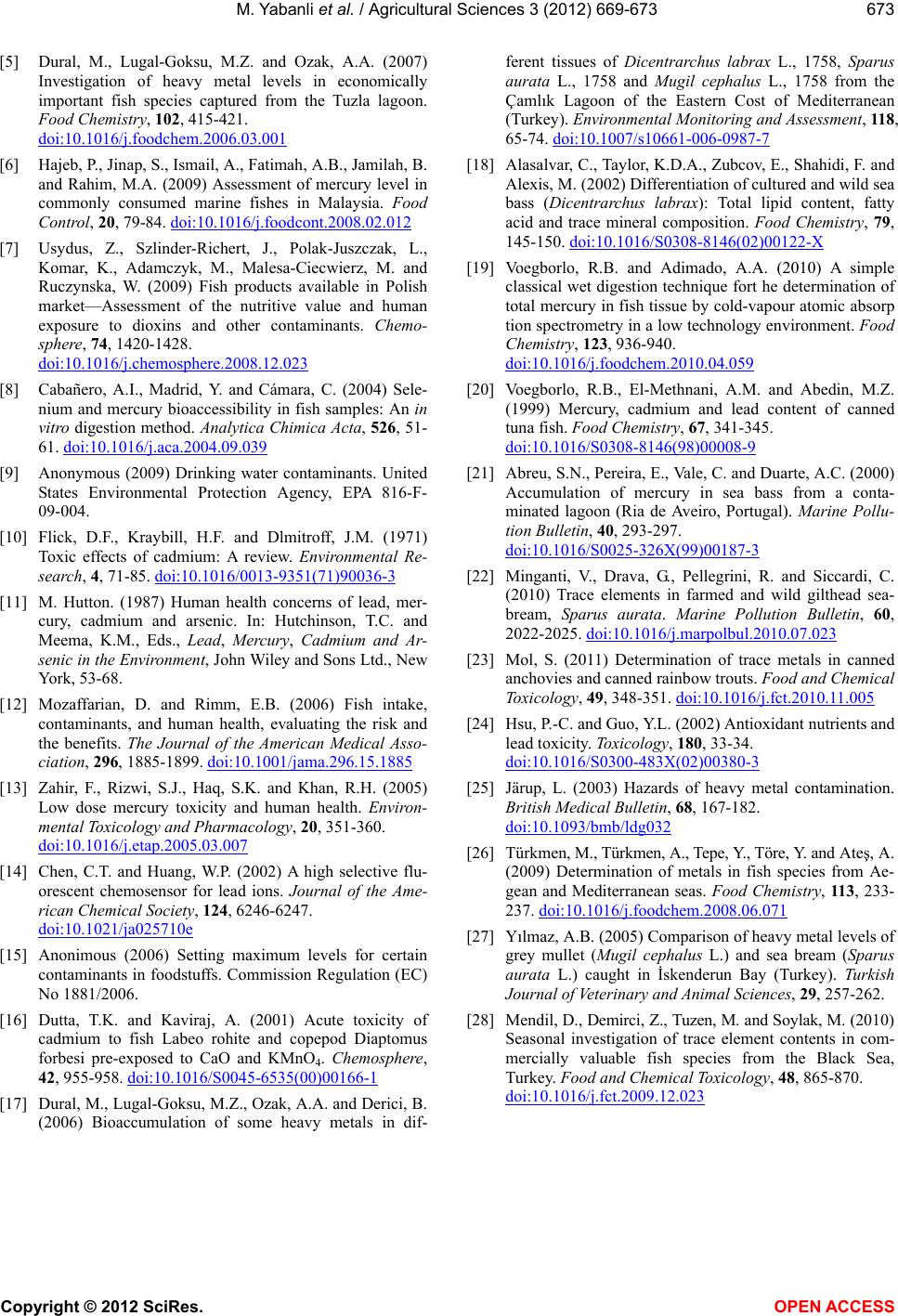
M. Yabanli et al. / Agricultural Sciences 3 (2012) 669-673 673
[5] Dural, M., Lugal-Goksu, M.Z. and Ozak, A.A. (2007)
Investigation of heavy metal levels in economically
important fish species captured from the Tuzla lagoon.
Food Chemistry, 102, 415-421.
doi:10.1016/j.foodchem.2006.03.001
[6] Hajeb, P., Jinap, S., Ismail, A., Fatimah, A.B., Jamilah, B.
and Rahim, M.A. (2009) Assessment of mercury level in
commonly consumed marine fishes in Malaysia. Food
Control, 20, 79-84. doi:10.1016/j.foodcont.2008.02.012
[7] Usydus, Z., Szlinder-Richert, J., Polak-Juszczak, L.,
Komar, K., Adamczyk, M., Malesa-Ciecwierz, M. and
Ruczynska, W. (2009) Fish products available in Polish
market—Assessment of the nutritive value and human
exposure to dioxins and other contaminants. Chemo-
sphere, 74, 1420-1428.
doi:10.1016/j.chemosphere.2008.12.023
[8] Cabañero, A.I., Madrid, Y. and Cámara, C. (2004) Sele-
nium and mercury bioaccessibility in fish samples: An in
vitro digestion method. Analytica Chimica Acta, 526, 51-
61. doi:10.1016/j.aca.2004.09.039
[9] Anonymous (2009) Drinking water contaminants. United
States Environmental Protection Agency, EPA 816-F-
09-004.
[10] Flick, D.F., Kraybill, H.F. and Dlmitroff, J.M. (1971)
Toxic effects of cadmium: A review. Environmental Re-
search, 4, 71-85. doi:10.1016/0013-9351(71)90036-3
[11] M. Hutton. (1987) Human health concerns of lead, mer-
cury, cadmium and arsenic. In: Hutchinson, T.C. and
Meema, K.M., Eds., Lead, Mercury, Cadmium and Ar-
senic in the Environment, John Wiley and Sons Ltd., New
York, 53-68.
[12] Mozaffarian, D. and Rimm, E.B. (2006) Fish intake,
contaminants, and human health, evaluating the risk and
the benefits. The Journal of the American Medical Asso-
ciation, 296, 1885-1899. doi:10.1001/jama.296.15.1885
[13] Zahir, F., Rizwi, S.J., Haq, S.K. and Khan, R.H. (2005)
Low dose mercury toxicity and human health. Environ-
mental Toxicolo gy and Pharmacology, 20, 351-360.
doi:10.1016/j.etap.2005.03.007
[14] Chen, C.T. and Huang, W.P. (2002) A high selective flu-
orescent chemosensor for lead ions. Journal of the Ame-
rican Chemical Society, 124, 6246-6247.
doi:10.1021/ja025710e
[15] Anonimous (2006) Setting maximum levels for certain
contaminants in foodstuffs. Commission Regulation (EC)
No 1881/2006.
[16] Dutta, T.K. and Kaviraj, A. (2001) Acute toxicity of
cadmium to fish Labeo rohite and copepod Diaptomus
forbesi pre-exposed to CaO and KMnO4. Chemosphere,
42, 955-958. doi:10.1016/S0045-6535(00)00166-1
[17] Dural, M., Lugal-Goksu, M.Z., Ozak, A.A. and Derici, B.
(2006) Bioaccumulation of some heavy metals in dif-
ferent tissues of Dicentrarchus labrax L., 1758, Sparus
aurata L., 1758 and Mugil cephalus L., 1758 from the
Çamlık Lagoon of the Eastern Cost of Mediterranean
(Turkey). Environmental Monitoring and Assessment, 118,
65-74. doi:10.1007/s10661-006-0987-7
[18] Alasalvar, C., Taylor, K.D.A., Zubcov, E., Shahidi, F. and
Alexis, M. (2002) Differentiation of cultured and wild sea
bass (Dicentrarchus labrax): Total lipid content, fatty
acid and trace mineral composition. Food Chemistry, 79,
145-150. doi:10.1016/S0308-8146(02)00122-X
[19] Voegborlo, R.B. and Adimado, A.A. (2010) A simple
classical wet digestion technique fort he determination of
total mercury in fish tissue by cold-vapour atomic absorp
tion spectrometry in a low technology environment. Food
Chemistry, 123, 936-940.
doi:10.1016/j.foodchem.2010.04.059
[20] Voegborlo, R.B., El-Methnani, A.M. and Abedin, M.Z.
(1999) Mercury, cadmium and lead content of canned
tuna fish. Food Chemistry, 67, 341-345.
doi:10.1016/S0308-8146(98)00008-9
[21] Abreu, S.N., Pereira, E., Vale, C. and Duarte, A.C. (2000)
Accumulation of mercury in sea bass from a conta-
minated lagoon (Ria de Aveiro, Portugal). Marine Pollu-
tion Bulletin, 40, 293-297.
doi:10.1016/S0025-326X(99)00187-3
[22] Minganti, V., Drava, G., Pellegrini, R. and Siccardi, C.
(2010) Trace elements in farmed and wild gilthead sea-
bream, Sparus aurata. Marine Pollution Bulletin, 60,
2022-2025. doi:10.1016/j.marpolbul.2010.07.023
[23] Mol, S. (2011) Determination of trace metals in canned
anchovies and canned rainbow trouts. Food and Chemical
Toxicology, 49, 348-351. doi:10.1016/j.fct.2010.11.005
[24] Hsu, P.-C. and Guo, Y.L. (2002) Antioxidant nutrients and
lead toxicity. Toxicology, 180, 33-34.
doi:10.1016/S0300-483X(02)00380-3
[25] Järup, L. (2003) Hazards of heavy metal contamination.
British Medical Bulletin, 68, 167-182.
doi:10.1093/bmb/ldg032
[26] Türkmen, M., Türkmen, A., Tepe, Y., Töre, Y. and Ateş, A.
(2009) Determination of metals in fish species from Ae-
gean and Mediterranean seas. Food Chemistry, 11 3, 233-
237. doi:10.1016/j.foodchem.2008.06.071
[27] Yılmaz, A.B. (2005) Comparison of heavy metal levels of
grey mullet (Mugil cephalus L.) and sea bream (Sparus
aurata L.) caught in İskenderun Bay (Turkey). Turkish
Journal of Veterinary and Animal Sciences, 29, 257-262.
[28] Mendil, D., Demirci, Z., Tuzen, M. and Soylak, M. (2010)
Seasonal investigation of trace element contents in com-
mercially valuable fish species from the Black Sea,
Turkey. Food and Chemical Toxicology, 48, 865-870.
doi:10.1016/j.fct.2009.12.023
Copyright © 2012 SciRes. OPEN ACCESS